
This imaginary project improves the public transport route between Euston and Canary Wharf. The route is already well served by public transport. Travelling on Underground trains, you complete the journey in half an hour at a speed of 11 mph. For comparison, the award-winning buses in my home town, Edinburgh, average 7 mph. The trams are a bit faster, at an average 14½ mph.
Therefore a new route needs to have some desirable feature which the present public transport routes do not offer, and it also has to be fast enough to compete with an electric underground railway.
The proposed new route satisfies these requirements by combining a non-stop route to the north bank of the River Thames with an express ferry. The resulting hybrid route is fast enough to be competitive and useful, and the ride on water is an attractive feature and a sort of saleable by-product for the ‘business tourism’ market.
Background
On 11 April, the magazine New Civil Engineer published an article by Katherine Smale titled Exclusive, Canary Wharf Group in talks about rail link to Euston stating that the government is considering having a new express Tube line built from, as the title implies, Euston to Canary Wharf.
On 17 April, the Web site
City Metric
published a related article,
Could London get a new tube line from Canary Wharf to Euston?.
The author,
Jonn Elledge,
asks what route the line might take,
and in particular whether the proposed line should take a route mainly through North London or through South London. Here are the two routes which Elledge considers, as well as a straight route which I use for comparisons. (The ikon  means that the link opens in a new window. The ikon
means that the link opens in a new window. The ikon
 means that there is a foot-note.)
means that there is a foot-note.)
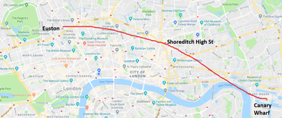
|
 |
Northern route through Shoreditch |
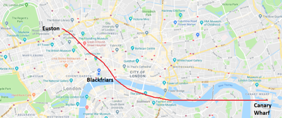
|

|
Southern Route through Southwark |
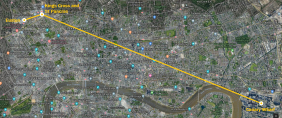
|

|
Straight line route including King’s Cross |
The distance by rail from Euston to Canary Wharf is at present 5 miles 48 chains, and it takes thirty minutes on the London Underground, changing at Tottenham Court Road and Bank. That gives an average speed just over 11 mph, which is not bad for public transport in a highly congested city. Travelling in a straight line with one station at King's Cross, an Underground train would cover the distance of 5 mi 27 ch from Euston to Canary Wharf in 14¼ minutes. Its average speed over the straight line route would be 22½ mph.
 1
1
While the choice of route is obviously important to engineers, Underground train drivers and people who like drawing lines on maps, passengers care little about the route which the train takes, since they can’t see anything out of the windows. The proposed hybrid service is reasonably quick and more interesting to the jaded international businessman than an underground tunnel running the whole distance. London is, after all, one of the world’s greatest cities and the least the government can do is to show it off to travellers from lesser places who might never see any of London otherwise. The proposed service also complies with Transport for London’s River Action Plan, published in 2013, which aims to double the number of people travelling by river, its target being 12M commuter and tourist trips every year.
The existence of wharves at Embankment and Canary Wharf and a navigable waterway linking the two suggests that the government ought, for at least five minutes, to consider planning a route via Embankment Pier. Passengers travel from Euston to Canary Wharf by Underground as far as Embankment Pier and by riverboat from Embankment Pier to Canary Wharf. It would make sense to pay the small additional cost involved in including King’s Cross and St Pancras stations in the scheme, since they are important arrival points for business passengers coming from Scotland, the north of England and the continent.
Euston to Embankment
From Euston to Embankment Pier, on the Thames, is barely two miles. The Northern Line already runs from Euston to Embankment. We have three choices:
(a)
use the Northern Line as it is, or
(b)
build bypasses around the intermediate stations on the Northern Line so that express trains can go past them without stopping, or
(c)
build a new underground line from King’s Cross and Euston to Embankment Pier. A railway tunnel from Euston to Embankment Pier would cost about £630M, from King’s Cross £850M.
 2
2
The Northern Line does not at present provide a direct link from King’s Cross to Euston. Using the Northern Line as it is will make the journey from King’s Cross to Embankment inconvenient since it will involve changing trains at Euston.
And at this point in the story, we can have fun drawing lines on maps.
 3
3

|

|
A service from King’s Cross to Embankment via Euston requires a change at Euston. |
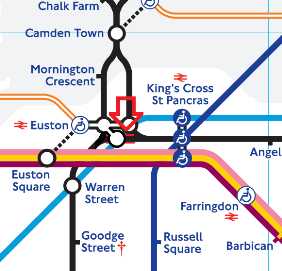
|

|
We can create a faster service from King’s Cross via Euston by constructing a short link from one branch of the Northern Line to the other. |

|

|
The creation of that link complicates the operating pattern of the Northern Line, which is already quite complicated.
This is the present operating pattern. Trains leave both King’s Cross and Euston for four different destinations. (Five if you count Kennington, where some southbound trains terminate.) |
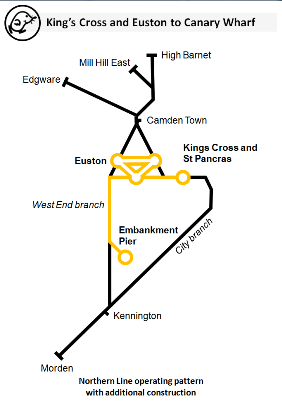
|

|
With a direct link from King’s Cross to Euston, trains leave both King’s Cross and Euston for five different destinations, or six if you count Kennington. |

|

|
This is the schematic diagram of the express service from King’s Cross and Euston to Embankment Pier, showing interchanges with other Underground lines and the ferry service to Canary Wharf. |
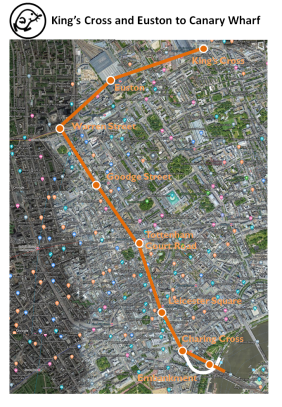
|
  4
4
|
We have now reached Embankment Pier.
A train from Euston to Embankment must pass through five intermediate stations. Stopping trains will delay the express service unless action is taken to prevent the delay. An express route, which requires the excavation of about two miles of tunnel, is one possibility. Another is the creation of by-passes so that trains on the Canary Wharf express service can pass through the stations without stopping while stopping trains still call at the platforms. Note that the existing tracks are used for the express trains so that they do not have to decelerate to run over the turnouts safely. Stopping trains slow down and use the turnouts. |

|

|
At some stations it will be possible to provide bay platforms for stopping trains, and non-stop trains will use the existing tracks. The existing platforms will be retained for such uses as emergency evacuations, access to track, or bomb shelters. A detailed survey of underground objects will be required to determine where this type of by-pass can be built. This type of by-pass can be used even when the running lines are vertically separated. |
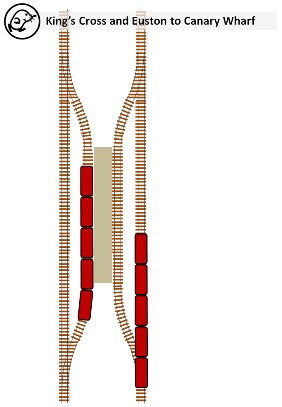
|

|
Where the running lines are horizontally separated by 60 ft or thereabouts, and they are not vertically separated, the bay roads can be built between the running lines. This results in lower cost, but passengers dislike island platforms. |

|

|
At the terminal of the express service, a bay platform needs to be provided so that trains operating the express service have time to lay over and for the driver to change ends. |
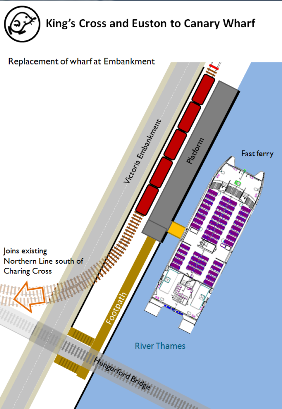
|

|
Although Embankment Station on the Northern Line is close to Embankment Wharf, it might be possible to provide quicker transfer from the Underground train to the ferry by building a station immediately beside the wharf on the lines of a marine station, like this.
|
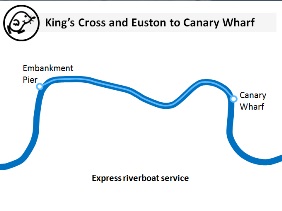
|

|
The route map of the riverboat link between Embankment Pier and Canary Wharf runs along a fairly straight segment of the River Thames. It is 5 mi 10 ch in length, which takes 10½ minutes.
No new piers need to be built although Embankment Pier could be adapted to offer fast rail to ship transfer. |
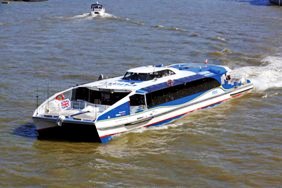
|

|
Catamaran riverboats of the type most recently acquired for passenger service on the Thames, operated by Thames Clippers, are Incat catamarans 35 ft 10 in long, 27 ft 3 in beam and capable of carrying 150 passengers at a speed of 25 kn. Each riverboat requires three or four crew.
The cost of a riverboat is expected to be about £3¼M.
It is expected that three riverboats would be sufficient to provide a service every ten minutes. |
Notes
1. Timings
for the Underground are taken from the published timetable.
Timings for the Thames ferries are taken from the MBNA Thames Clippers published timetable.
Speed of Edinburgh Trams are calculated from data in
Wikipedia
and Edinburgh Trams
timetable.
2. Costs.
I used the figure £315M per mile to estimate the cost of tunneling. The figure is taken from a light rail project in Toronto, converted to British Pounds at the inter-bank exchange rate. It is regarded as high by people who know more about tunnels than I do.
For a consideration of costs of urban railway in tunnel please refer to
Are Tunnels for Light Rail really cost prohibitive? by
Klaus Philipsen.
4. Maps
from Google Maps. Ferryboat drawings from First Ferries.
5. Ferry boats.
Capital cost from
Thames Clippers website.
Mechanical and performance data taken from
Shipping Today & Yesterday website.


![]() 3. Mole.
The cartoon drawing of a mole is adapted from the winning entry of a competition held in 1971 to find a logo for the Helsinki Metro.
3. Mole.
The cartoon drawing of a mole is adapted from the winning entry of a competition held in 1971 to find a logo for the Helsinki Metro.



No comments:
Post a Comment